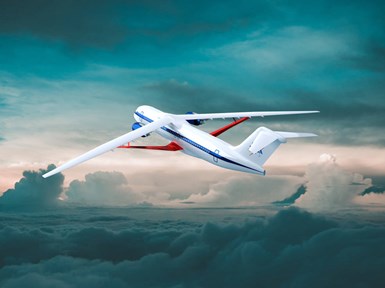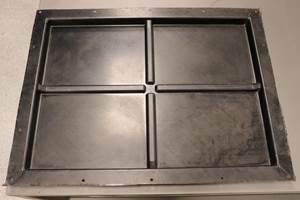Aviation Week survey shows airlines want Boeing to develop modern 757 replacement
Need for long-hauler with up to 250 seats and 20% cost reduction could open door for composites. Boeing is already preparing via new digital engineering chief and integrated product team.

Boeing 757-200. Photo Credit: Craig Sunter, Wikimedia Commons
“Just do it.” This is the answer airlines would give if asked whether Boeing (Chicago, Ill., U.S.) should launch a new narrowbody aircraft, reports Jens Flottau and Guy Norris in a Nov. 12, 2021 Aviation Week article. This answer, they say, is based on a recently published survey conducted by the Aviation Week Network in collaboration with Bank of America Global Research. The poll of more than 900 respondents includes a large number of airlines and lessors. Key findings include:
- Customers see need for up to 250 seats and long-haul capabilities.
- Most respondents would consider a small widebody.
- Boeing should target up to 20% unit-cost reduction.
The article notes that although details have leaked from Boeing’s late-2020 study of the new mid-market airplane (NMA)-derived -5X concept to potentially fill the 757-replacement niche and counter the Airbus A321XLR, Boeing has since retrenched to focus on 787 deliveries and certifying the 777X. It goes on to point out “lower-level preparations for the launch of new products quietly continue in the background while Boeing assesses market timing and opportunities.” These measures, Flottau and Norris report, “range from establishing teams to develop new technology flight decks and other systems to forming an integrated product team [IPT] to pave the way digitally for the design and production of its next commercial aircraft using capabilities and methods largely perfected on a recent set of military programs.” (See “Boeing to build new factory to produce MQ-25 Stingray.”)

An artist’s concept of the transonic truss-braced wing aircraft configuration to be developed through the Sustainable Flight National Partnership (SFNP). Photo Credit: NASA
The Aviation Week article also reports: “Boeing is polling industry for potential input to support its proposal to NASA for a new single-aisle sustainable flight demonstrator (SFD). A competitive program, which will likely be the largest purpose-built experimental aircraft in the seven-decade X-plane series, the new aircraft will form the core of NASA’s Sustainable Flight National Partnership (SFNP) plan with other agencies, industry and academia.”
Whether Boeing proceeds with a double- or single-aisle is important for composites because the former will almost certainly move toward a composites fuselage, following on from those used in the Boeing 787 and Airbus A350 widebody aircraft. A composites fuselage in a narrowbody, however, is less certain. Composite wings seem more likely regardless of fuselage width. CW has written about this before, in “Wither the commercial aerospace landscape” and “Boeing said to be evaluating new twin-aisle program.” Notably, a March 2021 article in Aviation Week asserted that any new aircraft with more than 150 seats launched this decade — for production through the 2030s and into the 2040s — will likely require a new geared turbofan engine; extensive use of composites, especially for the wings; and/or digital design and supply chain management to reduce cycle times, working capital, labor cost and the current heavy use of over-specialized jigs and tooling.
The latter is already well underway via the IPT described above and, as reported by the Seattle Times in late September, Boeing has appointed a digital engineering chief to lead preparations for both the design of its next new commercial jet and the integrated production system that will build it. “This effort will determine the standards and interfaces by which we are linked together with a digital thread through design, test, certification, build and support,” explained a company memo.
Read more about digital thread and Composites 4.0 manufacturing below:
- SAM-XL develops closed-loop manufacturing for composites
- Speeding RTM with heat-flux sensors
- Composites 4.0: Digital transformation, adaptive production, new paradigms
- Digital thread vs. digital twin
- No business case for reteaching robots
- Composites 4.0: Where to start?
Related Content
Microwave heating for more sustainable carbon fiber
Skeptics say it won’t work — Osaka-based Microwave Chemical Co. says it already has — and continues to advance its simulation-based technology to slash energy use and emissions in manufacturing.
Read MoreCryo-compressed hydrogen, the best solution for storage and refueling stations?
Cryomotive’s CRYOGAS solution claims the highest storage density, lowest refueling cost and widest operating range without H2 losses while using one-fifth the carbon fiber required in compressed gas tanks.
Read MoreTU Munich develops cuboidal conformable tanks using carbon fiber composites for increased hydrogen storage
Flat tank enabling standard platform for BEV and FCEV uses thermoplastic and thermoset composites, overwrapped skeleton design in pursuit of 25% more H2 storage.
Read MoreUniFORM: High-quality, high-complex EV battery enclosures at low cycle times, low tooling costs
Stellantis subsidiary CpK Interior Products Inc. recently completed a design challenge to prove out its vacuum-assisted wet compression molding process for CFRP battery trays.
Read MoreRead Next
Composites end markets: Energy (2024)
Composites are used widely in oil/gas, wind and other renewable energy applications. Despite market challenges, growth potential and innovation for composites continue.
Read MoreFrom the CW Archives: The tale of the thermoplastic cryotank
In 2006, guest columnist Bob Hartunian related the story of his efforts two decades prior, while at McDonnell Douglas, to develop a thermoplastic composite crytank for hydrogen storage. He learned a lot of lessons.
Read MoreCW’s 2024 Top Shops survey offers new approach to benchmarking
Respondents that complete the survey by April 30, 2024, have the chance to be recognized as an honoree.
Read More














.jpg;maxWidth=300;quality=90)











